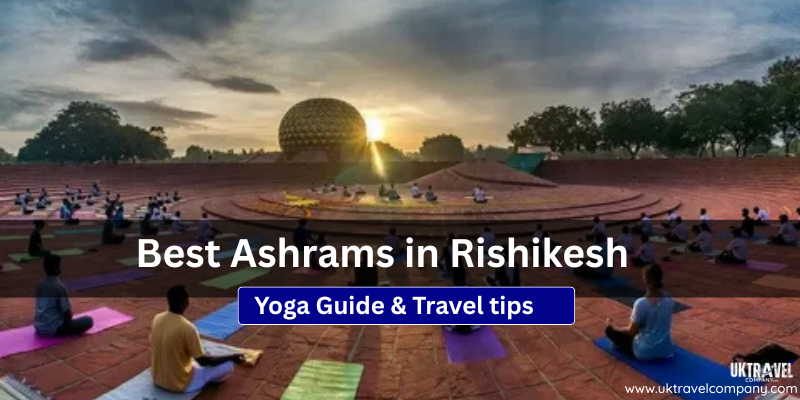Rishikesh, known as the Yoga Capital of the World, Best Ashrams in Rishikesh for Meditation is nestled on the banks of the holy Ganga and surrounded by the foothills of the Himalayas. It is a haven for spiritual seekers and yoga lovers. Whether you’re looking for deep meditation, traditional yoga, or a peaceful retreat from busy life, the right ashram can offer a life-changing experience.
In this guide, we’ll explore some of the best ashrams in Rishikesh for yoga and meditation, what to expect, how to choose the right one, and useful travel tips for your visit.
How to Choose the Right Ashram
| Criteria | Why it Matters |
|---|---|
| Location | Ashrams near the Ganga or in the hills provide a peaceful, natural atmosphere. |
| Programs Offered | Check if they offer daily yoga, meditation, satsang (spiritual talks), etc. |
| Teachers & Lineage | Experienced and authentic teachers make a huge difference in your journey. |
| Accommodation & Food | Clean rooms and healthy vegetarian food enhance your experience. |
| Duration & Cost | Some offer short-term stays (3–7 days), others have long retreats or courses. |
| Rules & Discipline | Many ashrams have guidelines like silent hours, no alcohol, and no smoking. |
Top Ashrams in Rishikesh for Yoga & Meditation
Here’s a curated list of the most recommended ashrams:
| Ashram Name | Key Highlights | Best For |
|---|---|---|
| Parmarth Niketan | Located by the Ganga, daily yoga/meditation, hosts International Yoga Festival, famous Ganga Aarti. | Beginners to advanced, spiritual tourists |
| Sivananda Ashram | Traditional Hatha Yoga, meditation, Vedanta classes, free programs for serious seekers. | Serious practitioners, spiritual seekers |
| Yoga Niketan | Focuses on silence, spiritual texts, disciplined routine, Ganga-facing rooms. | Intermediate to advanced seekers |
| Phool Chatti Ashram | 7-day structured retreat, peaceful nature setting, authentic teachings, organic food. | Beginners, wellness travelers |
| Omkarananda Ganga Sadan | Iyengar Yoga, daily classes, scripture studies, beautiful Ganga view. | Asana-focused learners, book lovers |
| Anand Prakash Ashram | Modern & traditional blend, Akhanda Yoga, teacher training courses, clean facilities. | Foreign travelers, comfort seekers |
| Swami Dayananda Ashram | Vedanta, meditation, spiritual depth, scholarly teachings. | People interested in Vedic studies |
What to Expect at a Rishikesh Ashram
- Daily Routine: Most ashrams follow a strict daily schedule — starting around 5–6 AM with yoga, meditation, karma yoga (seva), lectures, and evening satsang.
- Food: Pure vegetarian meals, often served twice or thrice a day. Some places are completely sattvic (no onion/garlic).
- Environment: Calm, disciplined, minimal use of electronics; expect to live simply and mindfully.
- Language: Most ashrams offer programs in English or with English translation.
- Booking: Advanced booking is highly recommended, especially between October–March.
Travel tips for Visiting Ashrams in Rishikesh
- Best Time to Visit: October to March is ideal — pleasant weather and spiritual festivals. Avoid peak monsoon (July–August).
- What to Pack:
- Comfortable, modest clothing (cover shoulders and knees)
- Yoga mat (some ashrams provide it)
- Shawl or sweater for cold mornings
- Water bottle, flashlight, basic medicines
- Respect the Rules:
- No alcohol, smoking, or drugs
- Silence during meditation hours
- Dress modestly and follow the code of conduct
- Stay Duration:
- Most ashrams offer stays from 3 days to several weeks. Choose based on your availability and experience level.
- Connectivity:
- Mobile network is decent in most areas. Wi-Fi may be limited in some ashrams — perfect for digital detox!
Conclusion
Rishikesh is more than just a destination — it’s an inner journey. Choosing the right ashram can open doors to deep transformation through yoga, meditation, spiritual learning, and peaceful living. Whether you’re a beginner or a long-time seeker, the ashrams of Rishikesh offer an environment that can reconnect you with yourself
FAQ – Ashrams in Rishikesh
1. Which is the best ashram in Rishikesh for beginners?
Parmarth Niketan and Phool Chatti Ashram are great for beginners due to their structured programs and supportive environment.
2. Are ashrams in Rishikesh free to stay?
Some ashrams like Sivananda Ashram offer free stays for serious seekers, but most charge a small fee for food and accommodation.
3. Do I need to book an ashram in advance?
Yes, especially during the peak season (Oct–March). Some ashrams allow walk-ins, but most prefer prior booking.
4. Can foreigners stay in Rishikesh ashrams?
Absolutely! Many ashrams welcome international visitors and offer programs in English.
5. Is it safe for solo travelers, especially women?
Yes, Rishikesh is generally safe. Choose well-known ashrams, follow local customs, and avoid late-night outings.
6. What is included in the ashram fee?
Usually, it includes accommodation, yoga classes, meditation sessions, and 2–3 vegetarian meals daily.



